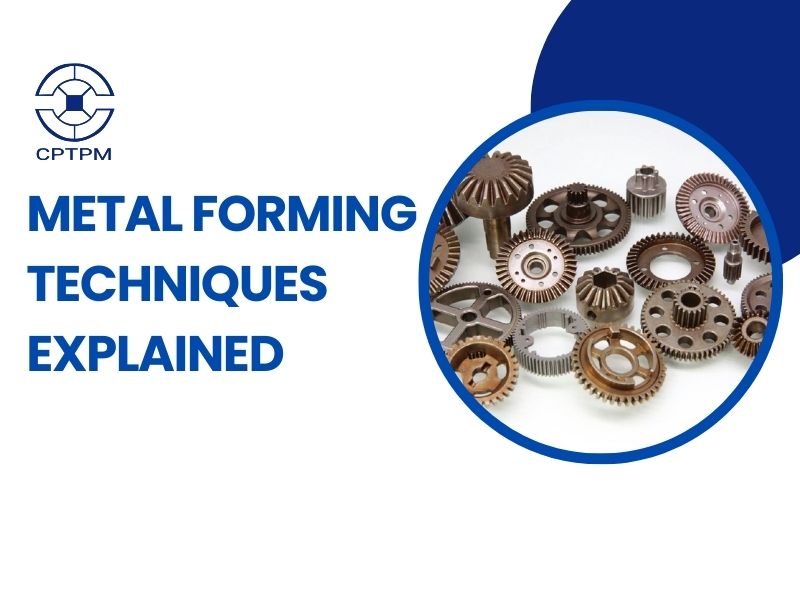Metal Forming Techniques Explained: From Forging to Powder Metallurgy
Introduction to Metal Forming
Metal forming is a vital manufacturing process that transforms raw metals into functional, high-performance components by applying mechanical force—without the need for material removal or addition. Through this process, metals are reshaped into specific geometries with enhanced mechanical properties, structural integrity, and dimensional precision.
This technique forms the backbone of modern production in sectors like automotive, aerospace, medical devices, electronics, industrial machinery, and consumer goods. It allows manufacturers to produce strong, durable parts efficiently and cost-effectively.
While traditional methods like forging and rolling continue to dominate heavy industry, advanced processes such as powder metallurgy are revolutionizing the way precision components are designed and produced.
At Ching Pen Ta Co., Ltd., we specialize in powder metallurgy-based metal forming solutions to deliver high-precision components for global industries.
Common Metal Forming Methods
- Forging
Heated metal is compressed between dies to form robust parts with excellent grain flow. Commonly used for crankshafts, connecting rods, and high-load components. - Rolling
Ideal for producing sheet metals and structural profiles, rolling involves passing metal through rollers to reduce thickness and improve surface finish. - Extrusion
A process where metal is forced through a die to create long objects with fixed cross-sections. It is used for parts like aluminum window frames, pipes, and rods. - Drawing
Used primarily for wire production, drawing stretches metal through a die to reduce diameter and enhance tensile strength. - Stamping & Deep Drawing
These sheet forming techniques shape flat metal into complex 3D forms using dies and punches—perfect for producing enclosures, automotive body parts, and appliance housings. - Powder Metallurgy
A modern metal forming process that compacts metal powders into shape and sinters them at high temperatures. It offers unmatched efficiency and is ideal for producing intricate, durable components with minimal material waste.
Advantages of Metal Forming
Metal forming offers numerous benefits that make it essential to a wide range of industrial applications:
- Material Efficiency
Especially in powder metallurgy, nearly all input material becomes part of the final product. - Mechanical Strength
Formed parts—especially forged or sintered ones—offer excellent strength and fatigue resistance. - Design Versatility
Allows for the production of complex, lightweight, and high-performance components. - High Repeatability
Once tooling is developed, the process ensures consistent part quality across large production volumes. - Faster Production Cycles
High-speed forming operations reduce production time and lead time compared to machining or casting. - Cost Savings
Reduced secondary processing, minimal scrap, and the ability to integrate multiple features into a single part significantly lower overall manufacturing costs.
Powder Metallurgy: A High-Precision Forming Technology
As industries demand smaller, stronger, and more complex parts, powder metallurgy (PM) has emerged as a critical solution in precision metal forming. It enables the production of components that are difficult or impossible to machine using traditional methods.
Key benefits of powder metallurgy include:
- Net-shape and near-net-shape capability, minimizing or eliminating the need for machining
- Excellent dimensional control and surface finish
- Ability to blend custom alloy compositions for unique performance needs
- Porosity control for self-lubricating or lightweight applications
At Ching Pen Ta Co., Ltd., powder metallurgy is not just a process—it’s our core competency. Since 1978, we’ve delivered OEM and ODM powder metallurgy components for:
- Automotive – transmission gears, engine bushings, brake system parts
- Pneumatic and Electric Tools – internal mechanisms such as ratchets, clutches, and drive shafts
- Industrial Machinery – couplings, cam followers, levers, and guide parts
- Lock Systems – compact, secure, high-tolerance lock components
- Electronics and Appliances – precision bearings, rotating parts, and noise-reduction components
We offer end-to-end solutions—from powder blend formulation to tooling design, sintering control, and quality assurance—ensuring every part meets performance and cost targets.
Your Partner in Advanced Metal Forming
Ching Pen Ta Co., Ltd., based in Taiwan, is a professional powder metallurgy manufacturer with over four decades of experience. Our ISO-certified production facilities house state-of-the-art equipment including high-tonnage presses, temperature-controlled sintering furnaces, and precision inspection systems.
We collaborate with clients worldwide—especially in Asia and Europe—to develop custom parts that meet strict mechanical, thermal, and wear-resistance requirements.
Whether you’re creating a new product or optimizing an existing one, we provide reliable support for every stage of development, including:
- Application review and material selection
- CAD/CAM mold design
- Prototyping and validation
- Scalable production for short and long runs
- Custom packaging and logistics services
Let’s Build Your Next Component Together
If you're looking for a dependable partner in metal forming or powder metallurgy, Ching Pen Ta Co., Ltd. is ready to help you achieve engineering excellence and cost-effective production.
☞ Contact Us Today to discuss your needs or request a free technical consultation.
